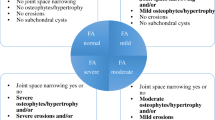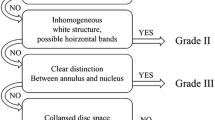Abstract
Objectives
To assess the reliability of change in lumbar magnetic resonance imaging (MRI) findings evaluated retrospectively by direct comparison of images and by non-comparison.
Materials and methods
Pre-treatment and 2-year follow-up MRI was performed in 126 patients randomized to disc prosthesis surgery or non-surgical treatment. Two experienced radiologists independently evaluated progress and regress for Modic changes, disc findings, and facet arthropathy (FA) at L3/L4, L4/L5, and L5/S1, both by non-comparison and by comparison of initial and follow-up images. FA was evaluated at all levels, and other findings at non-operated levels. We calculated prevalence- and bias-adjusted kappa (PABAK) values for interobserver agreement. The impact of an adjacent prosthesis (which causes artefacts) and image evaluation method on PABAK was assessed using generalized estimating equations.
Results
Image comparison indicated good interobserver agreement on progress and regress (PABAK 0.63−1.00) for Modic changes, posterior high-intensity zone, disc height, and disc contour at L3-S1 and for nucleus pulposus signal and FA at L3/L4; and moderate interobserver agreement (PABAK 0.46−0.59) on decreasing nucleus signal and increasing FA at L4-S1. Image comparison indicated lower (but fair) interobserver agreement (PABAK 0.29) only for increasing FA at L5/S1 in patients with prosthesis in L4/L5 and/or L5/S1. An adjacent prosthesis had no overall impact on PABAK values (p ≥ 0.22). Comparison yielded higher PABAK values than non-comparison (p < 0.001).
Conclusions
Regarding changes in lumbar MRI findings over time, comparison of images can provide moderate or good interobserver agreement, and better agreement than non-comparison. An adjacent prosthesis may not reduce agreement on change for most findings.


Similar content being viewed by others
References
Hutton MJ, Bayer JH, Powell J, Sharp DJ. Modic vertebral body changes: the natural history as assessed by consecutive magnetic resonance imaging. Spine. 2011. doi:10.1097/BRS.0b013e31821604b6.
Carragee E, Alamin T, Cheng I, Franklin T, van den Haak E, Hurwitz E. Are first-time episodes of serious LBP associated with new MRI findings? Spine J. 2006;6:624–35.
Park CK, Ryu KS, Jee WH. Degenerative changes of discs and facet joints in lumbar total disc replacement using ProDisc II: minimum two-year follow-up. Spine. 2008;33:1755–61.
Blondel B, Tropiano P, Gaudart J, Huang RC, Marnay T. Clinical results of lumbar total disc arthroplasty in accordance with Modic signs, with a 2 year minimum follow-up. Spine. 2011. doi:10.1097/BRS.0b013e31820f7372.
Harrop JS, Youssef JA, Maltenfort M, Vorwald P, Jabbour P, Bono CM, et al. Lumbar adjacent segment degeneration and disease after arthrodesis and total disc arthroplasty. Spine. 2008;33:1701–7.
Jarvik JG, Deyo RA. Moderate versus mediocre: the reliability of spine MR data interpretations. Radiology. 2009;250:15–7.
Jensen TS, Sorensen JS, Kjaer P. Intra- and interobserver reproducibility of vertebral endplate signal (Modic) changes in the lumbar spine: the Nordic Modic Consensus Group classification. Acta Radiol. 2007;48:748–54.
Kuisma M, Karppinen J, Niinimaki J, Kurunlahti M, Haapea M, Vanharanta H, et al. A three-year follow-up of lumbar spine endplate (Modic) changes. Spine. 2006;31:1714–8.
Luoma K, Vehmas T, Gronblad M, Kerttula L, Kaapa E. MRI follow-up of subchondral signal abnormalities in a selected group of chronic low back pain patients. Eur Spine J. 2008;17:1300–8.
Luoma K, Vehmas T, Gronblad M, Kerttula L, Kaapa E. Relationship of Modic type 1 change with disc degeneration: a prospective MRI study. Skeletal Radiol. 2009;38:237–44.
Sharma A, Pilgram T, Wippold 2nd FJ. Association between annular tears and disk degeneration: a longitudinal study. AJNR Am J Neuroradiol. 2009;30:500–6.
Hellum C, Johnsen LG, Storheim K, Nygaard ØP, Brox JI, Rossvoll I, et al. Surgery with disc prosthesis versus rehabilitation in patients with low back pain and degenerative disc: two-year follow-up of randomised study. BMJ. 2011;342:d2786. doi:10.1136/bmj.d2786.
Modic MT, Steinberg PM, Ross JS, Masaryk TJ, Carter JR. Degenerative disk disease: assessment of changes in vertebral body marrow with MR imaging. Radiology. 1988;166:193–9.
Modic MT, Ross JS. Lumbar degenerative disk disease. Radiology. 2007;245:43–61.
Fardon DF. Nomenclature and classification of lumbar disc pathology. Spine. 2001;26:461–2.
Aprill C, Bogduk N. High-intensity zone: a diagnostic sign of painful lumbar disc on magnetic resonance imaging. Br J Radiol. 1992;65:361–9.
Carrino JA, Lurie JD, Tosteson AN, Tosteson TD, Carragee EJ, Kaiser J, et al. Lumbar spine: reliability of MR imaging findings. Radiology. 2009;250:161–70.
Luoma K, Riihimaki H, Luukkonen R, Raininko R, Viikari-Juntura E, Lamminen A. Low back pain in relation to lumbar disc degeneration. Spine. 2000;25:487–92.
Raininko R, Manninen H, Battie MC, Gibbons LE, Gill K, Fisher LD. Observer variability in the assessment of disc degeneration on magnetic resonance images of the lumbar and thoracic spine. Spine. 1995;20:1029–35.
Videman T, Battie MC, Gibbons LE, Maravilla K, Manninen H, Kaprio J. Associations between back pain history and lumbar MRI findings. Spine. 2003;28:582–8.
Solgaard Sorensen J, Kjaer P, Jensen ST, Andersen P. Low-field magnetic resonance imaging of the lumbar spine: reliability of qualitative evaluation of disc and muscle parameters. Acta Radiol. 2006;47:947–53.
Masharawi Y, Kjaer P, Bendix T, Manniche C, Wedderkopp N, Sorensen JS, et al. The reproducibility of quantitative measurements in lumbar magnetic resonance imaging of children from the general population. Spine. 2008;33:2094–100.
Fujiwara A, Tamai K, Yamato M, An HS, Yoshida H, Saotome K, et al. The relationship between facet joint osteoarthritis and disc degeneration of the lumbar spine: an MRI study. Eur Spine J. 1999;8:396–401.
Sim J, Wright CC. The kappa statistic in reliability studies: use, interpretation, and sample size requirements. Phys Ther. 2005;85:257–68.
Jensch S, de Vries AH, Peringa J, Bipat S, Dekker E, Baak LC, et al. CT colonography with limited bowel preparation: performance characteristics in an increased-risk population. Radiology. 2008;247:122–32.
Mak HK, Yau KK, Khong PL, Ching AS, Cheng PW, Au-Yeung PK, et al. Hypodensity of >1/3 middle cerebral artery territory versus Alberta Stroke Programme Early CT Score (ASPECTS): comparison of two methods of quantitative evaluation of early CT changes in hyperacute ischemic stroke in the community setting. Stroke. 2003;34:1194–6.
Arana E, Royuela A, Kovacs FM, Estremera A, Sarasibar H, Amengual G, et al. Lumbar spine: agreement in the interpretation of 1.5-T MR images by using the Nordic Modic Consensus Group classification form. Radiology. 2010;254:809–17.
Altman D. Practical statistics for medical research. New York: Chapman & Hall; 1991.
White K, Berbaum K, Smith WL. The role of previous radiographs and reports in the interpretation of current radiographs. Invest Radiol. 1994;29:263–5.
Stieber J, Quirno M, Cunningham M, Errico TJ, Bendo JA. The reliability of computed tomography and magnetic resonance imaging grading of lumbar facet arthropathy in total disc replacement patients. Spine. 2009;34:E833–40.
Berg L, Neckelmann G, Gjertsen Ø, Hellum C, Johnsen LG, Eide GE, et al. Reliability of MRI findings in candidates for lumbar disc prosthesis. Neuroradiology. 2011. doi:10.1007/s00234-011-0963-y.
Robinson PJ. Radiology's Achilles' heel: error and variation in the interpretation of the Rontgen image. Br J Radiol. 1997;70:1085–98.
Jensen TS, Bendix T, Sorensen JS, Manniche C, Korsholm L, Kjaer P. Characteristics and natural course of vertebral endplate signal (Modic) changes in the Danish general population. BMC Musculoskelet Disord. 2009;10:81.
Emch TM, Modic MT. Imaging of lumbar degenerative disk disease: history and current state. Skeletal Radiol. 2011;40:1175–89.
Jensen RK, Leboeuf-Yde C. Is the presence of Modic changes associated with the outcomes of different treatments? A systematic critical review. BMC Musculoskelet Disord. 2011;12:183.
Sears WR, Sergides IG, Kazemi N, Smith M, White GJ, Osburg B. Incidence and prevalence of surgery at segments adjacent to a previous posterior lumbar arthrodesis. Spine J. 2010;11:11–20.
Lund T, Oxland TR. Adjacent level disk disease-is it really a fusion disease? Orthop Clin North Am. 2011;42:529–41.
Siepe CJ, Zelenkov P, Sauri-Barraza JC, Szeimies U, Grubinger T, Tepass A, et al. The fate of facet joint and adjacent level disc degeneration following total lumbar disc replacement: a prospective clinical, X-ray, and magnetic resonance imaging investigation. Spine. 2010;35:1991–2003.
Acknowledgments
We would like to thank the patients who participated in this study. The study received financial support from the Western Norway Regional Health Authority, Haakon and Sigrun Ødegaard’s Fund at the Norwegian Society of Radiology, the South Eastern Norway Regional Health Authority, and the Norwegian ExtraFoundation for Health and Rehabilitation through the Norwegian Back Pain Association.
Conflict of interest
The authors declare that they have no conflicts of interest.
Author information
Authors and Affiliations
Corresponding author
Additional information
The study received financial support from the Western Norway Regional Health Authority, Haakon and Sigrun Ødegaard’s Fund at the Norwegian Society of Radiology, the South Eastern Norway Regional Health Authority, and the Norwegian ExtraFoundation for Health and Rehabilitation through the Norwegian Back Pain Association.
Rights and permissions
About this article
Cite this article
Berg, L., Gjertsen, Ø., Hellum, C. et al. Reliability of change in lumbar MRI findings over time in patients with and without disc prosthesis—comparing two different image evaluation methods. Skeletal Radiol 41, 1547–1557 (2012). https://doi.org/10.1007/s00256-012-1394-5
Received:
Revised:
Accepted:
Published:
Issue Date:
DOI: https://doi.org/10.1007/s00256-012-1394-5




